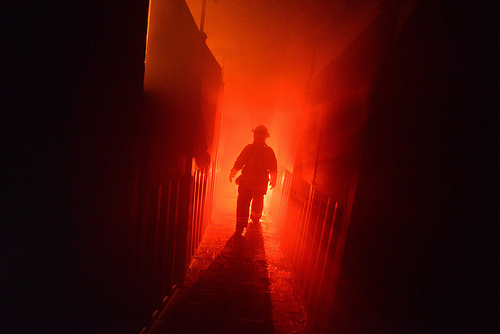Constructing the Two Goals for the Protagonist in Your Novel
In these first posts in our year-long course, we’re exploring the four corner support pillars in novel construction. These four pillars are crucial and should be soundly built before the rest of the novel elements are worked in. My experience in both writing and critiquing novels has taught me that without these four elements solidly built, a novel will collapse. Sometimes on the first page. Oftentimes, I’m sad to say.
Writing a novel is complex. Unfortunately, many people think they can just dive in and write without much preparation. They’ve read a lot of novels, they say. Isn’t that all you need to know how a novel “works”? No, it’s not.
It’s Not Easy Keeping All Those Plates Spinning
I liken writing a novel to spinning about twenty plates (using sticks) in the air at one time. Every seen someone do that? It takes serious precision, balance, concentration, and keen focus. The elements in your novel all have to spin at the same time. If one wobbles too wildly, it can knock all the rest of the plates off their sticks. With experience, a novelist can tell when a plate is starting to wobble unsteadily. It could be a character’s arc, a lag in conflict, a series of nothing scenes.
I suppose there is a similarity here to the image of pillars holding up a roof. Both the sticks and the pillars have to be able to hold something up. The point being: novel writing takes some thoughtful planning to ensure all the elements work together in a smooth dance.
A Recap
So let’s recap. We’ve looked at concept with a kicker—the first support pillar. If you haven’t gone through those posts, I recommend you do, and then download the Inspection Checklist 1-concept with a kicker so you can get to work on honing your concept. If you’ve already written your novel, this course and the checklists will help you both assess where your pillars are weak (or which plates are wobbling uncontrollably) and aid you in revising your story so it’s strong and compelling.
Last week we started examining the second corner pillar—protagonist with a goal. We looked at how a protagonist must have a visible goal, and how that goal needs to be brought out very early in your novel. Preferably in the first scene. And the sooner the better. Why is this so important?
Because you want the reader to “get” what your book is about. Without a clearly defined goal for your protagonist, your reader won’t know what the premise is. The protagonist’s goal is the linchpin that connects every element together. Setting up the goal establishes the finish line for your story.
Think about most of the popular movies you’ve seen. The story opens showing a character in his ordinary world. Something happens to upend it, and a goal is born. Or the movie starts with a character already pursuing a goal, but then something happens, making it now seemingly impossible for the hero to reach that goal. I would venture to say that every great book and movie, unless experimental or purposely bizarre, will showcase a protagonist striving to reach a goal.
Not Just One but Two Goals
If you followed my course in 2012—Writing the Heart of Your Story—you know there are really two goals for your protagonist. Without writing an entire post or two on this, you can get the gist of it in this post here. With every visible goal a character has (and yes, all your main and secondary characters need visible goals), there needs to be an emotional/spiritual goal. This has much to do with your character arc and how each character will change and be changed by the end of the book.
As the protagonist strives to reach her goal and faces numerous challenges, obstacles, and choices, the experience changes her. Her goal is tied up with a core need, a passion, a dream. It is something she must get, have, stop, or reach. Her emotional nature and spirituality are tied to that goal.
Is your novel about a man whose child has been kidnapped and now he must go save her? Is your novel about a woman who is greatly opposed to abortion but whose daughter will die if she doesn’t abort her baby? Is your novel about a man whose biggest dream is to make it to the top of Everest? Whatever the visible goal is, there is emotional need connected (or there better be).
That core need drives the character toward his goal, which he may or may not reach at the climax of the book (your choice). But the key to this corner pillar is in establishing and building the visible and spiritual goals throughout the book, where they are both resolved at the same time in the same scene at the climax. That will take some planning and some careful plate spinning.
The Goal Ties In with Theme, Concept, and Conflict
Well, how do you come up with these goals for your protagonist? The first step is to get a clear handle on your concept and kicker. We looked at ideas and how an idea is not enough to make a novel strong and compelling. Once you come up with your concept, explore the ways your main character can be the vehicle to showcasing that concept. His goal needs to be centered on that concept, and the themes that are brought out tie in with his core emotional and spiritual needs.
The father seeking to rescue his kidnapped daughter is compelled by fierce love, among many other emotions. The themes that arise from this concept may have to do with self-sacrifice, loyalty, not allowing fear to rule, good wins out—whatever you see your take-home message to be. If you want to write a story about the death penalty, and you want to show it’s wrong, for example, you would create a protagonist with a visible goal that showcases your theme. Many movies have explored this theme by showing how a person was put to death for a crime he didn’t commit. The protagonist may have been the man’s attorney, sister, child, friend.
Goals are tied in with themes. Protagonists need a visible goal that will explore those themes. They need a spiritual/emotional goal that will bring passion and tension to the story. And then conflict and opposition must be positioned to stand in the way of the protagonist reaching his goal (which we’ll get into soon in future posts). In some ways this is very simple and straightforward. In other ways, it’s like trying to keep twenty plates spinning in the air. But with practice and knowledge of the way these plates spin and balance, it can be done—and in a way that looks effortless and easy.
Rather than give you four separate definitions of these pillars, I’m trying to get you to see they work in sync together. You can’t just have one; you need all four. And because they are so interconnected, they need to be worked on together. They look like four individual pillars that stand alone. But together they bear all the weight—jointly and in perfect position. If you take one pillar out or weaken one, it will seriously compromise the integrity of the structure.
So I hope I’ve given you some things to think about regarding your protagonist and his goal. We’ll go further into what makes a great protagonist in next week’s post. Happy spinning!
Have any thoughts about protagonists and establishing their goals right from the start?
Inspection checklists:
Inspection Checklist 1-concept with a kicker
Photo Credit: Don Fulano via Compfight cc












Awesome!! I am learning so much!! Thank you!!
Your first checklist was amazing! I’d been working on my novel for about a month and I had it pretty much outlined. But going through the checklist and answer the 12 questions really helped understand what my story was about and clarified doubts I had. My plot feels a lot stronger now that I’ve nailed doing the ‘concept and kicker’ for my story because I really wasn’t sure what that was before filling out the checklist. I can’t wait for the second checklist. 😉
Thanks so much! I didn’t want to overwhelm writers with all the questions so I’m glad they get you thinking and focusing on the core of your story. The next checklist is coming up!
I’ve been enjoying the series very much and learning new things. Thank you! 🙂
I’ve come late to your course, but I’m finding it extremely helpful for improving my WIP and clarifying my plot and character elements.
I was getting quite stuck on defining what my visible goal was, as the stated goal from my first chapter changes shortly afterwards.
So I was quite relieved to read in one of your posts from last year: “Often the first goal the character sets isn’t the actual plot goal.” Aha!
Now once I’ve unjumbled my character’s emotional goal from my themes, I’ll have a much better understanding of my story.
Linda, I think the more common structure is to show the character in her ordinary world pursuing some ordinary goal until the first disturbance occurs (hopefully very soon) to upset that world (and goal) and force her in another direction. That new direction defines the new goal for her and the book. Think of the classic hero’s journey in which the hero is called to action and then must undertake the journey. It’s the same thing, essentially. But when thinking about your premise and concept, you want that main goal for the book in mind, and that should be one clear goal. Make sense?
I am really enjoying your series. It is like taking a home based writing course. You do provide a lot to think about. You are very generous to be offering all this wonderful advice gratis on your blog site! Perhaps I can return the favour down the road when I have a MS to edit.
Thank you, Karen~
I have been receiving these posts by email, and I keep going back to the character ones because that is where my fatal weakness lies. These posts break down the elements of characterization so that I understand the concepts as I’ve never really understood them before. They are so helpful! Thank you so much!
I am not sure why the goal must be visible. I have read your other posts but still wonder why a spiritual goal that guides a character’s response to a situation would not suffice. Then again if I was to specifically define a spiritual goal it feels too mystical. Say a child character has been brought up by a bad dude to steal; like in Oliver Twist. If the child feels guilty and that puts him on a path to discover if what he/she does is right or wrong and then try to stop. It seems that the spiritual goal comes first and sets things going for this character. Your thoughts please.
Well, the simple reason is you have to have plot. Something has to happen in the story. It’s hard to pull off a novel in which characters sit around talking just trying to make a relationship work. Granted there are literary novels that don’t follow this accepted structure, but they’re very challenging to do well. Readers just expect to see the main character pursuing some kind of goal that’s tangible, even if their primary goal is spiritual. Hope that makes sense.
I thought my approach, which is to dive in with only a vague idea of where I’m going, is more common than defining theme, concept, characters and their goals in advance. I begin a story – short story or novel – with no clear sense of who the characters are, no synopsis, plot, or timeline. Those things begin to emerge as I write a story that arose from an itch in need of a good scratch. Now I wonder if there are others like me. I’d give examples, but I don’t really want to talk about myself. I just want to put out, for instance, that even when starting blind, the POV character’s goals and the action he’s going to take will emerge soon enough just by keeping my nose to the ground. I literally discover the story as I go even when it springs from an experience I’ve had. To organize much in advance lessens my spirit of discovery.
I’d love to hear what Ms. Lakin and others have to say. This is such an interesting conversation!
Jim
Hi Jim, a lot of people “wing it” and just dive into writing, and there’s nothing wrong with that to a point. At some point, to have a strong story, there needs to be tight structure, so a lot of “pansters” (people who write by the seat of their pants) who actually write great novels do, whether deliberately or intuitively, start pulling all their material together into structure that works. I just find it much easier to plan most of the novel out structurally so it doesn’t cause problems later. Writers often veer off into all directions, and their characters like to take over without permission. And that can wreak havoc on clear intentions 🙂
Ms. Lakin, I should have gone on but didn’t want to talk on and on. Even in short stories, at some point I had to impose structure. When I wrote my first novel, two-thirds of the way through the rough draft I needed to make a timeline in order to understand where I had gone and think about that in order to see where I was going. Now in my second novel I am aware of that need sooner. You are right about how much it helps. But because I follow my nose, so to speak, and learn from the characters where they want to go and who they want to become, the direction I think I want it to go isn’t always what happens. Sometimes they veer in a different direction. Of course, I get to overrule them! I have the authority to do that! So, it would be better to say that I begin without structure, then find one, follow it to a certain extent, and veer within certain boundaries. But it is very helpful to be reminded of the importance of maintaining control. So, thanks for your response. You make this blog experience most helpful and enjoyable.
Could you please help me to understand if the Search for Redemption is a visible/outer goal? And if yes, then the inner goal (underlying motivations) would be to reduce the burden of guilt, lessen the regret? Is my understanding correct? I realise I am struggling with the visible/tangible goal vis-a-vis the the inner goals.
No worries. I was glad to have an opportunity to explain further. It takes a while to get the hang of this. Some used to call this the hook. “What’s your book’s hook?” you’d be asked. But now we think of hook as an opening to a scene or book. But the kicker is the hook. It’s what makes your story concept unique and compelling.
Think of the character’s inner motivation as what propels him toward his visible goal. A character searching for redemption, such as in The Kite Runner, will go after a goal to help him achieve that redemption. It’s specific. The spiritual goal is what you are talking about, which is the character trying to get his core need met. The way he goes about it is the visible path and goal.
For instance, you might want to make up with your mother after twenty years of separation due to a big fight. Your core need and motivation is to stop feeling guilty and pained. You miss her and long for things to be the way they were. So … what plot goal would you come up with to achieve that inner spiritual goal? You could devise a way to get her on a cruise ship, where she can’t really escape you, then show up and surprise her. Or you could kidnap her and take her to a cabin in the woods and destroy the car. This is silly, I know. But I hope you see the point. The plot, as I explain in The 12 Key Pillars and on my blog, is a vehicle for your character to go after her goal. It’s the “how.” The inner goal is all about “why.”
Hello Lakin. Thank you very much indeed. Two things from your response really helped me make the differentiation. The How and the Why and the Plot Goal and the Spiritual Goal. The mother example, especially the kidnapping bit may be silly, but sometimes I guess we really need things to be simplified to understand complex aspects.
I really appreciate the time and effort you have taken out to help me understand this. It is evident that you are equally passionate about helping people by sharing your knowledge.